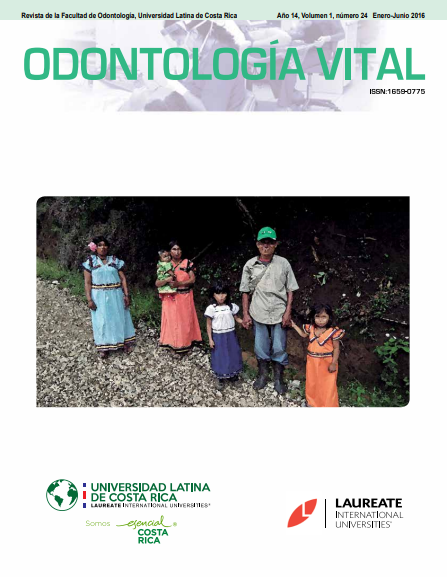Hospital discharge due to temporomandibular joint disorder from 1997 to 2013, CCSS
DOI:
https://doi.org/10.59334/ROV.v1i24.255Keywords:
Temporomandibular Joint Disorder, TMD, EpidemiologyAbstract
The following descriptive study analyzes reported cases of temporomandibular disease disorder, according to the database of registered hospital discharged from the Health Statistics Area of the Costa Rican Social Security occurred during the years 1997 to 2013, which analyzed the behavior of the epidemiological variables of time, place and person; frequency measurements and nonparametric statistics. The purpose of this article is to investigate the mix of case that would give the professional in dentistry, a tool for early diagnosis which contributes to the individual establishment of prevention and intervention of risk factors detected.
A total of 167 cases of temporomandibular joint disorder were recorded according to the International Classification of Diseases ICD-10. The ratio from the obtained results was 2.71 females for every male graduate with temporomandibular joint disorder. Age rate obtained predominance in the population of 20-44 years being 5.63 X 100.00 inhabitants and a relative risk for this same group of 10.64 and the rate per geographical location in our country was 8.37 per 100,000 inhabitants, this for the case of the Limon province.
Downloads
References
Carlsson C. (1999). Epidemiology and treatment need for temporomandibular disorders. Journal of orofacial pain; 13: 232-237.
Di Paolo,C., Costanzo, D., Panti, F., Rampello, A., Falisi, G., Pilloni, A., Cascone, P., Iannetti,G. Epidemiological analysis on 2375 patient with TMJ disorders. Rev. Annali di Stomalologia,4(1):161-169
De la Torre, E., Aguirre, I., Fuentes, V., Peñón, P., Espinoza, P., Núñez, J. (2013). Factores de riesgo asociados a trastornos temporomandibulares. Revista Cubana Estomatología, vol. 50(4):364-373
Fletcher, M., Piecuch, J., Lieblich, S. (2004). Anatomy and Pathophysiology of the Temporomandibular Joint. Principles of Oral and Maxillofacial Surgery, 47: 932-47.
Grau, I., Fernández, K., González, G., Osorio, M., (2005). Algunas consideraciones sobre los trastornos temporo-mandibulares. Revista Cubana Estomatología, vol. 42(3):1-11
Grau, I., Almagro, S., Cabo, R. (2007). Los trastornos temporomandibulares y la radiación láser. Rev. Cubana Estomatología, vol. 44(3):00
Medina, A. (2010). Prevalencia de trastornos temporomandibulares y su relación con la pérdida de soporte oclusal en adultos. Tesis Perú: Universidad Nacional Mayor San Marcos; 14-27
Okenson, J. (2003). Tratamiento de oclusión y afecciones temporomandibulares. (5ta Edición). Madrid España: Elsevier, Mosby, 148-80.
Okenson, J. (1999).Temporomandibular disorders in children. Rev. Pediatr Dent, Vol2 (4):325-326.
Organización Panamericana de la Salud. (1995). Clasificación estadística internacional de enfermedades y problemas relacionados con la salud.10a. Revisión. Washington, D.C: OPS, vol. 3; 554
Peñón, P., Grau, I., Sarracent, H., (2011). Síndrome de disfunción temporomandibular y factores asociados. Hospital Miguel Enríquez 2009-2010. Revista Habanera de Ciencias Médicas, vol10 (4): 448-457
Pérez, E., Aldana, E., Ruelas, M., Díaz, R. (2005). Frecuencia de trastornos temporomandibulares en mujeres climatéricas en el Instituto Nacional de Perinatología. Revista Asociación Dental Mexicana, Vol. 62(3):85-90
Pérez, O., Reyes, A., (2011). Patología de la articulación temporomandibular y su tratamiento. Revista Medicina Oral, julio-setiembre, vol. 13(3):78-83
Quirós, P., Monje, F., Vázquez, E. (2006). Diagnóstico de la patología de la articulación temporomandibular (ATM). Protocolos Clínicos de la Sociedad Española de Cirugía Oral y Maxilofacial, 19: 269-282.
Taboada, O., Gómez Y., Gutiérrez, S., Mendoza, V. (2004). Prevalencia de signos y síntomas de los trastornos tem-poromandibulares en un grupo de adultos mayores. Revista Asociación Dental Mexicana, vol. 61(4):125-129.
Tallents, R., Marcher, D., Stephanos, K., Katzberg, R., Moss, M. (2002). Prevalence of missing posterior teeth and intraarticulartemporomandibular disorders. The Journal of Prosthetic Dentistry, 87(1): 45-50. https://doi.org/10.1067/mpr.2002.121487
Downloads
Published
Issue
Section
License
Copyright (c) 2016 William Lao Gallardo, Karen Sobalvarro Mojica

This work is licensed under a Creative Commons Attribution 4.0 International License.
Authors who publish with Odontología Vital agree to the following terms:
- Authors retain the copyright and grant Universidad Latina de Costa Rica the right of first publication, with the work simultaneously licensed under a Creative Commons Attribution 4.0 International license (CC BY 4.0) that allows others to share the work with an acknowledgement of the work's authorship and initial publication in this journal.
- Authors are able to enter into separate, additional contractual arrangements for the non-exclusive distribution of the Odontología Vital's published version of the work (e.g., post it to an institutional repository or publish it in a book), with an acknowledgement of its initial publication.
- Authors are permitted and encouraged to post their work online (e.g., in institutional repositories or on their website) prior to and during the submission process, as it can lead to productive exchanges, as well as earlier and greater citation of published work.







